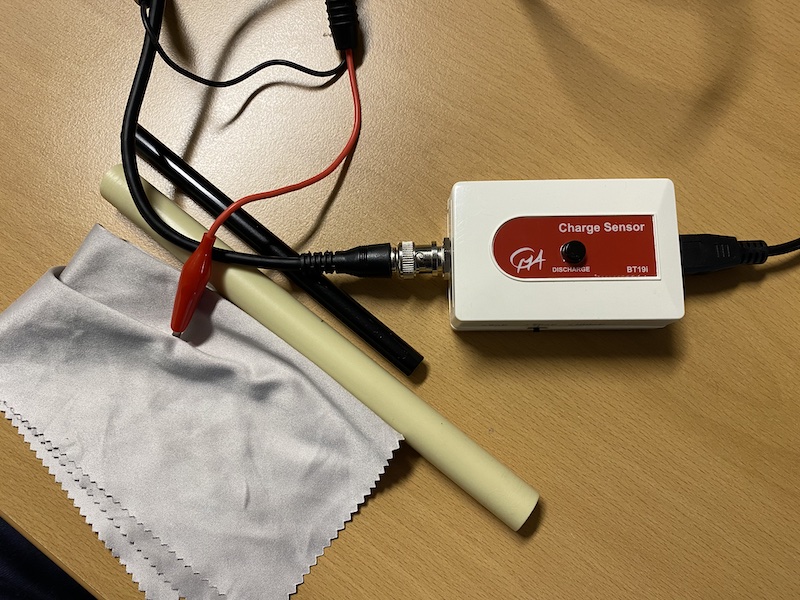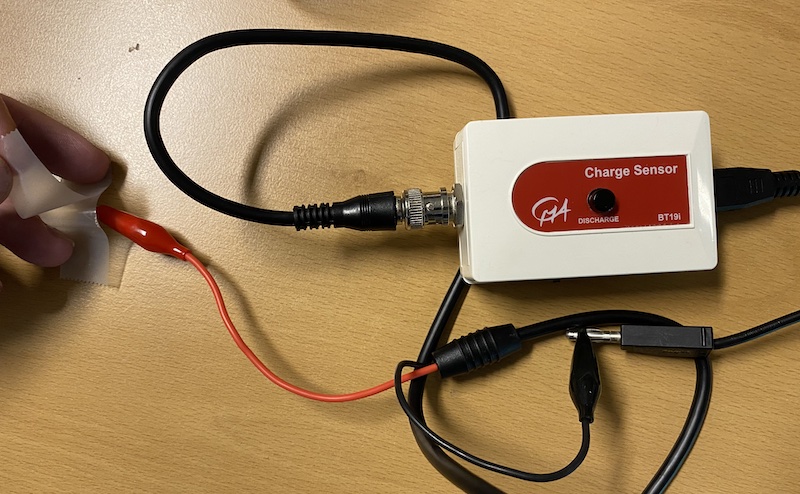16.3. Measuring charge#
| Author: | Norbert van Veen |
| Time: | 10 minutes |
| Level: | Grade 8 and up |
| Concepts: | Charge |
Introduction#
Students are taught about charge and electric fields. In demonstrations, teachers charge various objects. However, determining the magnitude and sign of the electric charge on these objects can be challenging. In this demonstration, we use a charge sensor to measure the magnitude and sign of the charge. The charge sensor shows that the charge of the cloth used for rubbing is opposite to that of the object used in the demonstration.
Equipment#
Charge sensor
Tape (3M Scotch tape)
Cloth
Various plastic rods

Fig. 16.6 The charge sensor, plastic rods, and a cloth used to charge the objects by rubbing.#
Preparation#
Connect the charge sensor to the interface and start Coach 7 or similar measuring program. Ensure that the sensor’s value is displayed in a window. Set the sensor to a range of \(\pm\) 25 nC using the adjustment knob.
Connect the black clip of the sensor to a ground. Reset the sensor using the reset button. Display the measurement on a large screen, such as a digital board.

Fig. 16.7 The charge sensor is grounded via a CoachLabII+ interface. The red clip of the sensor is held near the separated pieces of tape.#
Procedure#
Take two equal-length pieces of tape. Stick one piece onto the back of the other piece (see Figure 16.7, at the left). Rub over them with your finger. Verify that the charge is 0 nC.
Pull the pieces of tape apart and measure the charge of each piece separately.
Ask the students to make sense of the measurements.
What will we measure if the pieces of tape are stuck back together?
Rub a plastic rod with a cloth and measure the charge of the rod.
To check students’ understanding, ask: What is the charge of the cloth?
After resetting the sensor, also measure the charge of the cloth.
Tip
You can also separate the tape in duplicate. Then show that the pieces of tape can attract or repel each other.
When charging a rod, rub in one direction (up or down but not up/down).
Physics background#
Friction causes charge separation. Initially, the objects are neutral. Friction causes some electrons to move, resulting in one object being charged oppositely to the other. The magnitude of the charge in these experiments is on the order of tens of nC.
Follow-up#
There are many demonstration with static charge, for instance: Rub a balloon on your head and hang it against the wall. What causes it to stick against the wall?
